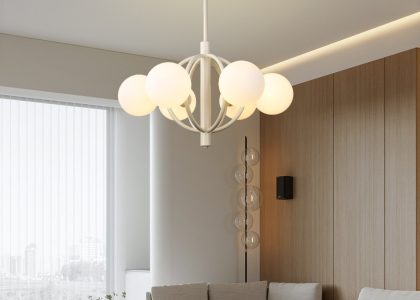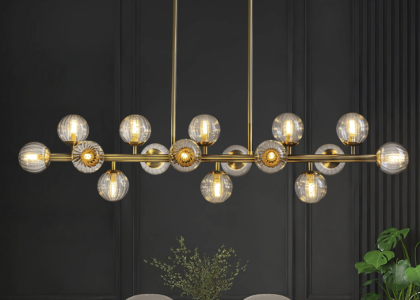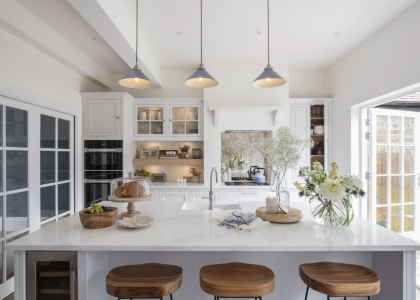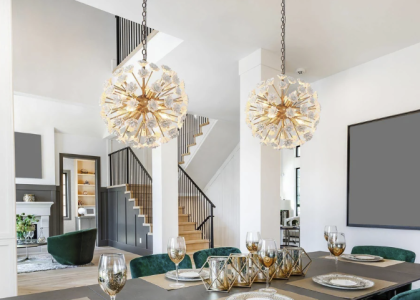Chandeliers Mosundesign have a long and rich history that dates back to ancient times. The word “chandelier” is derived from the French word “chandelle,” which means candle. The earliest chandeliers were simple wooden crosses with spikes to hold candles, and they were used to illuminate large rooms and halls. These early chandeliers were primarily used in churches and monasteries, where they provided much-needed light for religious ceremonies and gatherings.
As time progressed, chandeliers evolved from simple wooden structures to more elaborate designs made from metal, such as bronze and iron. The use of glass and crystal also became popular, adding a touch of elegance and luxury to chandeliers. During the medieval period, chandeliers were often adorned with intricate designs and symbols, reflecting the religious and cultural beliefs of the time. It wasn’t until the 15th century that chandeliers began to be used in private homes, marking a shift from their exclusive use in religious and public spaces.
By the 18th century, chandeliers had become a symbol of wealth and status, with elaborate designs and expensive materials such as crystal and gold being used to create stunning pieces that adorned the grandest of palaces and mansions. The Industrial Revolution brought about significant changes in chandelier production, with the introduction of gas lighting and later, electric lighting, leading to the mass production of chandeliers and making them more accessible to the general public.
The Evolution of Chandelier Design
The evolution of chandelier design has been a fascinating journey, with each era leaving its mark on the style and construction of these iconic lighting fixtures. From the simple wooden crosses of ancient times to the opulent crystal chandeliers of the 18th century, chandeliers have undergone significant transformations in their design and construction.
During the Renaissance period, chandeliers became more ornate and decorative, with intricate metalwork and the use of colored glass adding a touch of elegance to their design. The Baroque and Rococo periods saw the rise of grand chandeliers adorned with crystals and elaborate motifs, reflecting the opulence and extravagance of the time. The introduction of gas lighting in the 19th century led to the development of gasoliers, which were chandeliers designed to hold gas lamps instead of candles.
The Art Nouveau and Art Deco movements brought about a shift in chandelier design, with a focus on geometric shapes, clean lines, and the use of new materials such as chrome and glass. The mid-20th century saw a resurgence of interest in traditional chandelier designs, with many manufacturers producing replicas of classic styles from previous centuries. Today, chandelier design continues to evolve, with contemporary designers pushing the boundaries of creativity and innovation, using a wide range of materials and technologies to create unique and striking pieces that cater to modern tastes and lifestyles.
Choosing the Right Chandelier for Your Space
Choosing the right chandelier for your space is essential to creating the perfect ambiance and aesthetic appeal. When selecting a chandelier, it’s crucial to consider the size and style of the room, as well as the overall design scheme and lighting needs. A large, ornate chandelier may be suitable for a grand foyer or dining room, while a smaller, more understated design may be better suited for a bedroom or study.
The height of the ceiling should also be taken into account when choosing a chandelier, as a low-hanging fixture can make a room feel cramped, while a high ceiling may require a larger chandelier to fill the space adequately. Additionally, the style of the chandelier should complement the existing decor and architectural features of the room, whether it’s traditional, modern, or eclectic.
Consider the type of lighting you need when selecting a chandelier. Some chandeliers provide ambient lighting, while others are designed to cast a focused light for tasks such as reading or dining. It’s essential to choose a chandelier that meets your specific lighting requirements while adding beauty and elegance to your space.
The Impact of Chandeliers on Interior Design
Chandeliers have a significant impact on interior design, serving as both functional lighting fixtures and stunning decorative elements that can elevate the overall aesthetic of a space. A well-chosen chandelier can become the focal point of a room, adding drama, elegance, and personality to any interior.
In grand ballrooms and palaces, chandeliers are often used to create a sense of opulence and grandeur, while in more intimate settings such as dining rooms or bedrooms, they can add a touch of romance and sophistication. The style and design of a chandelier can also influence the overall mood and atmosphere of a room, whether it’s traditional, modern, or eclectic.
Chandeliers are versatile in their ability to complement various interior design styles, from classic and ornate designs that suit traditional spaces to sleek and minimalist fixtures that enhance modern interiors. Their ability to provide both ambient and task lighting makes them an essential element in interior design, allowing for flexibility in creating different lighting effects to suit different occasions and activities.
Maintaining and Cleaning Your Chandelier
Maintaining and cleaning your chandelier is essential to ensure its longevity and keep it looking its best. Regular dusting can help prevent dirt and grime from building up on the surface of the fixture. Use a soft cloth or duster to gently wipe down the individual components of the chandelier, taking care not to apply too much pressure or force that could damage delicate parts.
For more thorough cleaning, it’s essential to follow the manufacturer’s instructions for your specific chandelier model. Some chandeliers may require disassembly for cleaning, while others can be cleaned in place using a mild cleaning solution and soft cloth. Avoid using harsh chemicals or abrasive materials that could damage the finish or components of the chandelier.
If your chandelier has crystal components, it’s essential to clean them regularly to maintain their sparkle and shine. A mixture of water and mild dish soap can be used to gently clean crystal pieces, followed by a thorough rinse with clean water and careful drying with a soft cloth.
Regular maintenance checks are also crucial for ensuring that your chandelier is in good working condition. Check for loose or damaged parts, such as broken crystals or bent metalwork, and address any issues promptly to prevent further damage or safety hazards.
The Symbolism and Prestige of Chandeliers

Chandeliers have long been associated with symbolism and prestige, representing wealth, luxury, and sophistication. Throughout history, they have been used as status symbols in grand palaces, mansions, and public buildings, serving as a visual representation of power and influence.
In addition to their symbolic significance, chandeliers have also been used as decorative elements in religious ceremonies and rituals, symbolizing enlightenment, spirituality, and divine presence. Their use in churches, temples, and mosques reflects their association with sacred spaces and spiritual significance.
The prestige of owning a chandelier has not diminished over time; in fact, it has only increased with their widespread availability in various styles and price points. Today, owning a chandelier is often seen as a statement of refined taste and appreciation for fine craftsmanship and design. Whether it’s an antique crystal chandelier passed down through generations or a modern designer piece purchased for a contemporary home, chandeliers continue to hold a special place in interior design as symbols of elegance and sophistication.
Chandeliers in Modern Architecture and Design
Chandeliers continue to play a significant role in modern architecture and design, with contemporary designers pushing the boundaries of creativity and innovation to create unique and striking pieces that cater to modern tastes and lifestyles. Modern chandeliers come in a wide range of styles, materials, and sizes, offering endless possibilities for adding drama and elegance to any space.
In modern architecture, chandeliers are often used as statement pieces in commercial buildings such as hotels, restaurants, and event spaces. Large-scale installations featuring custom-designed chandeliers can create breathtaking visual effects that enhance the overall ambiance and atmosphere of these spaces.
In residential design, modern chandeliers are used to add personality and style to interiors, whether it’s a sleek minimalist fixture in a contemporary living room or a bold sculptural piece in a high-ceilinged foyer. The use of innovative materials such as recycled glass, metal alloys, and LED technology has expanded the possibilities for creating environmentally friendly and energy-efficient chandeliers that meet the demands of sustainable design practices.
The integration of smart technology has also influenced modern chandelier design, allowing for customizable lighting effects and control options that cater to the needs of today’s tech-savvy homeowners. With their ability to provide both functional lighting and aesthetic appeal, modern chandeliers continue to be an essential element in contemporary architecture and design.





